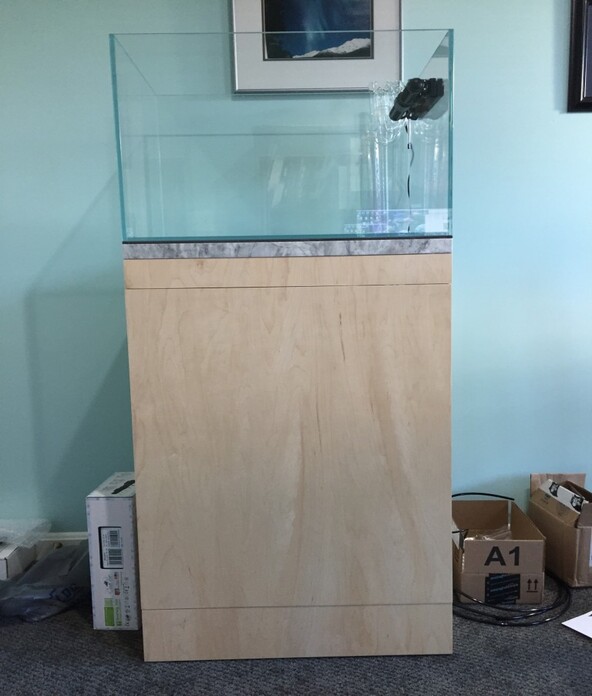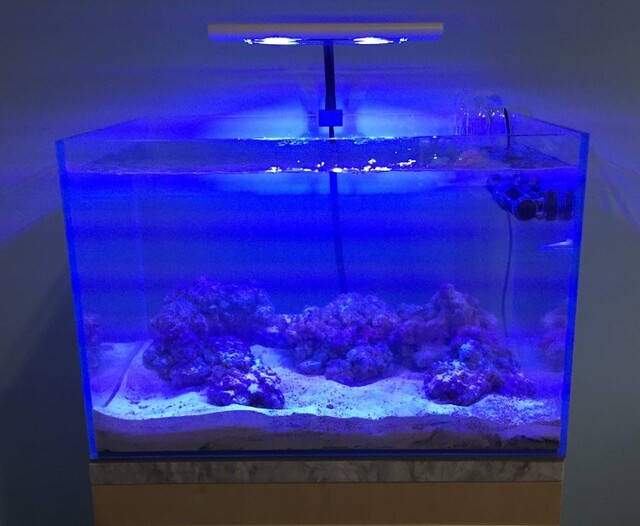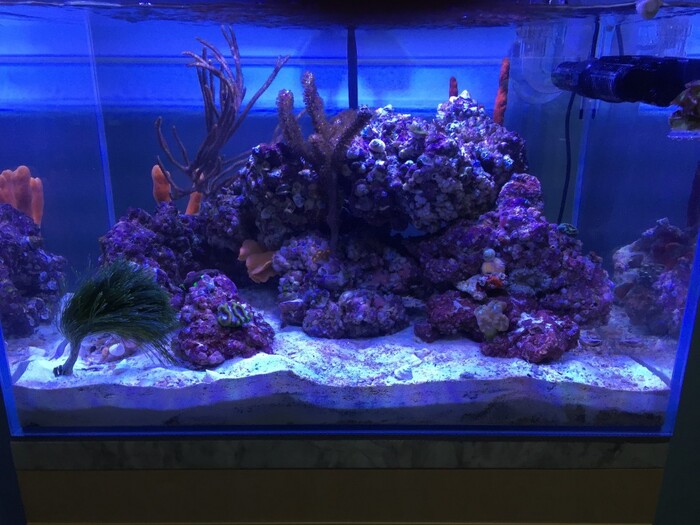Want to go from empty aquarium to ready-to-go reef in a box as fast as possible? Aqua-cultured live rock is a very fun, quick way to get there.
Some people are die-hard fans of aqua-cultured live rock and others wouldn’t use it if you paid them. As for me, you can now count me as one of the die-hard fans. Here’s why…
This was my new 24g rimless tank two weeks ago:

This is it one-and-a-half weeks ago:

And this is it today – fully cycled, already containing several newly added coral frags, and just a couple weeks away from being ready for fish (although I won’t be adding fish for 75 days – I explain why in a future post):

The first thing you need to do with a new saltwater aquarium is cycle the live rock you put into it. This usually takes 2-4 weeks when using regular, cured live rock and involves a LOT of water changes and rock scrubbing. And months if you start out with dry rock and cure it from scratch yourself.
By using fresh, uncured, aqua-cultured live rock I was able to cycle my tank in just over two weeks without any water changes and absolutely no rock scrubbing. My ammonia never went above 0.4 ppm.
Using aqua-cultured live rock doesn’t always guarantee a cycle that is this quick and smooth – it is not unheard for ammonia to go above 1 ppm and require one or more water changes. More often than not though it is quicker and requires few water changes than typical cured live rock — and almost never requires scrubbing of the rock.
There are a couple of other advantages to using fresh, uncured, aqua-cultured live rock as well, along with some disadvantages.
The pros of using aqua-cultured live rock:
- Tons of life on the rocks right from day 1: Since fresh, aqua-cultured live rock has been pulled straight from the ocean floor just few days (or even hours) before going in your tank, it is covered in all kinds, of barnacles, mollusks, sponges, crabs, coral and other life – including ALREADY being home to the beneficial bacteria that live on live rock and make it such a beneficial ‘biological filter’ for your aquarium – which is the primary point of having live rock in the first place
- It’s eco-friendly: the people who ‘farm’ aqua-cultured rock within the U.S. (and several other nations) are required to use either millennium-old coral rock that has been quarried from dry land, man-made rock, or legally harvested dry coral rock that is then dropped into the ocean populates with the bacteria and other sea life before being collected. In this way, no natural existing reefs are disturbed or illegally harvested
- It can save you a ton of time and effort: as you’ve already seen, it almost always takes far less time and effort to go from a new tank to a semi-mature tank versus other types of rock
Of course, like most things in life, it does have trade-offs…
The cons of using aqua-cultured live rock:
- Tons of life on the rocks right from day 1: Wait, isn’t that supposed to be a ‘pro’? Well, yes… and sometimes no. Most of the life than can come in on freshly aqua-cultured live rock is very desirable – but now and then a few hitchhikers can tag along that aren’t, such as: mantis shrimp, gorilla crabs, stone crabs, whelks, and a few others. It all depends if you’re willing to deal with plucking them out of your tank if any do stowaway on the rock.
- Slightly less freedom to aqua-scape the rock exactly how you want it: because you are working with randomly sized and shaped chunks of rock that show up on your doorstep HAVE TO go straight into saltwater and are already covered with a ton of life, you don’t have the leisure of choosing, drilling, chiseling, or fitting together a rock feature that exactly matches an aqua-scape you may already have in mind. You’re limited to working with and piecing together the shapes you get.
- Extra shipping costs: really nice fresh aqua-cultured live rock can be had for between $5-$7 per pound. This compares quite well to the $7-$9 local fish stores frequently charge for regular, cured live rock. However, since the aqua-cultured live rock is so live and fresh it must be shipped overnight in bags of seawater- and this can make for some very significant shipping costs. How much total cost difference there will be between the two will depend on how much your local fish stores charge for their live rock.
If you are interesting giving fresh, aqua-cultured live rock a try there are several places online where you can get it – two of the most popular on the saltwater aquarium forums are Tampa Bay Saltwater (which is where I got mine from – it was a 20g ‘Package‘) and KP Aquatics.
As for me, I’ll definitely be going with aqua-cultured live rock if I set up additional saltwater aquariums in the future.



